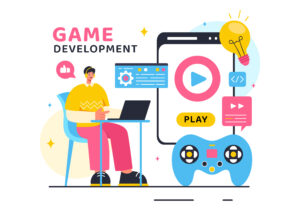The Rise of AI in Game Development: What to Expect in 2025
by Animatics Asset Store in Blog on December 12, 2024Every now and then, a buzzword floats into our ether and entices tech-savvy folks faster than gamers flocking to a midnight release. Today, it’s all about AI in game development—a trend hotter than a GPU trying to keep up with a next-gen title. But what can the average button masher or seasoned developer really expect as we move towards 2025? Let’s dive in, shall we?
Understanding AI in Gaming:
Remember when the idea of AI in games was limited to enemies running in predictable patterns, occasionally forgetting how to walk around a crate? Nostalgia aside, today’s game AI algorithms are far more advanced. Developers are leveraging artificial intelligence in gaming to create smarter, more adaptable environments and characters that react with uncanny realism.
Imagine an opponent who learns your strategies, growing more challenging as you attempt (and fail) to defeat them. AI-powered systems can simulate complex decision-making processes, enabling opponents to act unpredictably and adapt dynamically. It’s like trying to best my grandmother in chess—just when you think you’ve outsmarted her, she adapts again. 😊
Intelligent Character Design:
Gone are the days of static, one-dimensional characters. Modern AI creates NPCs that adapt to the player’s behavior, remember past interactions, and respond with depth and personality. These advancements in NPC behavior simulation ensure every character has its own motivations and can contribute to a more immersive narrative.
For example, real-time decision-making AI allows NPCs to dynamically change their actions based on evolving scenarios. An NPC could betray the player during a pivotal mission or offer assistance based on prior choices. This intelligence adds unpredictability, making the gaming experience far more engaging.
Procedural Content Generation:
Through procedural content generation, developers can use AI to generate expansive worlds, quests, and environments that feel authentically handcrafted. With AI-driven tools, landscapes can evolve based on player actions, ensuring no two playthroughs are the same.
Think of it as having an infinite number of Dungeon Masters at your disposal. AI isn’t just creating static content—it’s crafting interactive, living worlds that grow and adapt alongside the player. Developers rely on game AI algorithms to automate this process, freeing up time for them to focus on refining other aspects of the game.
Personalized Gaming Experiences
One of the most exciting advancements in AI in game development is its ability to tailor gaming experiences to individual players. AI systems can monitor players’ actions and preferences, adjusting difficulty, tone, or even narrative direction in real time.
Imagine starting an RPG where the AI observes your playstyle and subtly tailors the world to match. If you’re a stealthy player, enemies might become more alert to shadows and subtle sounds. If you’re more action-oriented, you’ll encounter AI opponents that provide a dynamic combat challenge. This level of customization ensures that every session feels fresh and uniquely personal.
AI-Powered Game Design
AI isn’t just for in-game characters and environments, it’s transforming the way games are built. AI-powered game design tools can analyze massive datasets to predict player preferences, optimize mechanics, and improve balance. Developers are increasingly using machine learning in games to refine mechanics based on beta testing feedback.
For example, AI can detect which levels players find too difficult or which mechanics feel unbalanced, allowing developers to tweak designs before launch. This approach not only improves player satisfaction but also ensures a smoother gaming experience.
Enhancing Game Physics Simulation
Realistic physics are an essential part of modern games, and AI is playing a major role in improving game physics simulation. AI systems can calculate complex interactions between objects in real-time, ensuring environments react as they would in the real world.
From destructible buildings in action games to fluid dynamics in open-world settings, AI-driven physics engines ensure that every interaction feels lifelike. These advancements are particularly valuable in VR and AR, where immersion hinges on believable physical interactions.
Pathfinding and Navigation Systems
One of the most practical applications of AI in gaming is improving pathfinding and navigation systems. This technology ensures NPCs can traverse complex environments without glitches or awkward movements.
AI-driven navigation systems calculate optimal paths for characters, even in procedurally generated landscapes. This ensures smooth, natural movement, whether it’s a teammate following you through dense forests or enemies chasing you in intricate urban settings.
Real-Time Rendering and Visuals
In addition to gameplay, AI is transforming the visual side of game development. Real-time rendering powered by AI enables developers to create lifelike graphics and environments with minimal manual effort. These tools can analyze lighting, textures, and shadows, dynamically adjusting visuals to enhance realism.
For example, artificial intelligence in gaming can assist in creating photo-realistic environments for next-gen consoles, ensuring a cinematic experience that feels tangible. Developers are also integrating AI with 3D modeling software to streamline asset creation, further accelerating production timelines.
Potential Challenges:
As promising as AI advancements are, they aren’t without challenges. Over-reliance on AI-powered game design can lead to overly complex systems that fail under real-world conditions. For example, poorly implemented game AI algorithms can result in frustrating bugs, such as NPCs getting stuck or reacting inconsistently.
Security is another concern. As games become more reliant on AI, protecting player data and digital assets becomes critical. Developers must implement robust systems to safeguard against vulnerabilities, ensuring players can enjoy the benefits of AI without compromising their safety.
Looking Ahead: What’s Next for AI in Game Development?
By 2025, we can expect even more groundbreaking innovations in AI in game development. From adaptive gameplay mechanics to fully dynamic narratives, AI is poised to redefine what games can achieve. Players will encounter worlds that feel alive, where every interaction carries weight and every choice has consequences.
Imagine walking through a procedurally generated city where every NPC has its own schedule, relationships, and goals. This level of complexity, powered by machine learning in games, will blur the line between virtual and real worlds.
Conclusion: The Future of Gaming
The rise of AI in game development represents a thrilling new chapter for the industry. From smarter NPCs to personalized gaming experiences, these advancements promise to make games more immersive, engaging, and dynamic than ever before.
However, with great power comes great responsibility. Developers must balance innovation with accessibility, ensuring that AI-driven games remain enjoyable for all players. As we approach 2025, one thing is certain: the possibilities for artificial intelligence in gaming are endless.
Are you excited about the future of AI in gaming? Share your thoughts and let’s discuss the incredible potential of this transformative technology.






